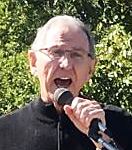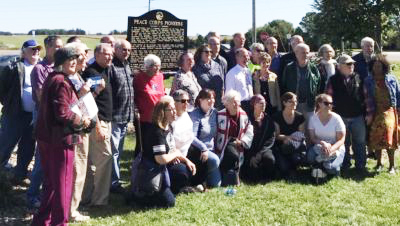First ever Peace Corps marker dedicated in Plainview MN
Ken Fliés of Eagan, MN was one of the first Peace Corps Volunteers, and the youngest when he began his service in Brazil in 1961.

Ken Fliés
Fliés, now 75, grew up on a dairy farm near Plainview, MN, and was just 19 when he answered President John F. Kennedy’s call to find “what you can do for your country.” He chose to represent the U.S. as a PCV in Correntina, in rural Brazil, where he would use his mechanical and agricultural skills to help fix a dam and improve the town’s farming skills.
Fliés understood hard work and how to make things work when times were tough, and these were the character strengths he would draw on during his 21-month tour in what proved to be a very unorganized inaugural launch of the Peace Corps. “It was pretty chaotic,” he said. “We were spread out over 15,000 square miles of the São Francisco Valley. There was no PC administration there. We were just left there to figure out what we were going to do.”
“And it wasn’t only the lack of structure,” he said. The political atmosphere was dangerous . . . even before he left the states. The group’s training took place Alabama, and happened amid race riots that required the trainees to be sequestered in trailers guarded by state troopers.
“My epic journey to the remote central highlands of Brazil, where I did not speak with my family or loved ones for 21 months, proved to be . . . just as its slogan promised . . . the toughest job I would ever love,” he said.
To cope with the isolation, Fliés found similarities between Correntina and Plainview. Both were small towns. At the time, Plainview had only 1,400 residents. Both were primarily Catholic. Both had a big river running nearby. Both were agricultural based.
“I had a really good support structure in the town I was in,” he said. “There was a very dynamic priest there. You weren’t going to fail on his watch. He was very helpful.”
Fliés was most interested in working with the farmers, but when he arrived the pressing need in Correntina was to finish a partly-constructed hydroelectric dam. “I had a strong basis in mechanics that I learned on the farm,” he said. During his second year, he was able to get back out in the farm field.
“I would never in a million years have come home to my dad and said that I gave up,” he said.
“THEY THOUGHT I HAD DIED”
Brazilians can’t say the letters “th” very well, Fliés said, so instead of calling him Kenneth, they called him “Señor Kennedy.”
When word reached the village that President Kennedy had been killed, they thought at first it was Fliés who had died.
“When I walked into the marketplace, they all stared at me,” he said. “It was like Jesus at the resurrection.”
Fliés mourned the passing of JFK, but found the villagers’ reaction both bewildering and heartwarming.
They looked at the U.S. transition of power from Kennedy to Lyndon Johnson with curiosity as Brazil went through its own political upheaval. Their president had been ousted by a coup. They also feared that the Peace Corps would be pulling out, since it was Kennedy who had taken Minnesota Senator Hubert H. Humphrey’s idea for the Peace Corps and made it law.
“There were three days of mourning in Brazil,” Fliés said. “There were people who came to our door in a line to offer their condolences. It was so amazing.”
Extending his service
One lesson he learned from his Peace Corps experience was a better understanding about how to help in foreign countries. “What did the Brazilians lack?” he asked himself. “They lacked information. If they had the information, they could figure out how to do things. That’s what the computer revolution is all about.” And over time Ken has used technology to bring helpful information to farmers in Brazil and other countries. In other words, he continued to do Peace Corps work, just on his own.
A book
On the 50th anniversary of the Peace Corps in 2011, Fliés dug out his old diaries from his Peace Corps days that had changed his life, and offered them to the Minnesota Historical Society. They encouraged him to use the diaries to write a memoir.
He started writing, and then his wife, Millie, his high school sweetheart he’d been married to for 52 years, was diagnosed with cancer. She was bedridden for 16 months before she died.
 This summer, Fliés published his book about his experiences. Titled Into the Backlands, Fliés combines his memories with historical events to create a complete picture of what it was like to be in the Peace Corps in the 1960s.
This summer, Fliés published his book about his experiences. Titled Into the Backlands, Fliés combines his memories with historical events to create a complete picture of what it was like to be in the Peace Corps in the 1960s.
While there are several Peace Corps books on the market, Fliés said his may be the last book written by anyone from that first group, since he was the youngest and many from the first tour have passed away, including the other three Peace Corps Pioneers from Plainview.
He joked that his book would be the omega to Rhoda and Earle Brooks’ alpha, The Barrios of Manta — the first book written by a Minnesotan about the Peace Corps experience.
The marker
The idea of the marker surfaced in 2011 at the time of the 50th anniversary of the Peace Corps. The process was completed in 2014 when the marker was installed. The impetus for considering a marker at the 50th anniversary of the Peace Corps was based on the significant efforts of Minnesotan Hubert Humphrey’s in establishing the Peace Corps and Minnesota’s early and continuous leadership in supplying Volunteers.
The idea to place it in Plainview was based on information I submitted to the State Historical Society that lead me to write Into the Backlands. In these materials it was discovered that four of the original Volunteers in the first year of the Corps came from this small town of 1,400 citizens — a town which also contributed a dozen Volunteers in the first fifty years of the Peace Corps. Since a large proportion of Volunteers come from small American communities and serve in small villages around the world, this was considered by the State to be an appropriate place for an historical marker.
There were three principal government entities involved in making the marker happen. The first was the State of Minnesota. In 1988, Minnesota’s voters approved a constitutional amendment establishing the Environment and Natural Resources Trust Fund (Trust Fund). The purpose of the Trust Fund is to provide a long-term, consistent, and stable source of funding for activities that protect and enhance Minnesota’s environment and natural resources for the benefit of current citizens and future generations.
The money in the Trust Fund originates from a combination of contributions and investment income. Forty percent of the net proceeds from the Minnesota State Lottery are deposited to the Trust Fund each year; this contribution is guaranteed by the Minnesota Constitution until December 31, 2024. The Trust Fund may also receive contributions from other sources such as private donations.
The Arts and Cultural Heritage Fund as part of this receives 19.75 percent of the sales tax revenue resulting from the Clean Water, Land and Legacy amendment to support arts, arts education and arts access, and to preserve Minnesota’s history and cultural heritage.
Projects for access to these funds needs a sponsoring 501-C3 entity. The sponsoring entity in this case became the City of Plainview, MN, based on the unique circumstances mentioned above. Proposed projects need to complete an in-depth application that is reviewed and approved by the Minnesota State Historical Society. This process also required historical validation of the information on the marker and background supporting information. This validation material in this case involved supporting information from the Peace Corps, NPCA and independent and State Historical Society historians.

Ken Fliés, 5th from left, in the black sweater and khaki pants, poses with other Peace Corps Volunteers by the historical marker for “Peace Corps Pioneers” in Plainview, MN, during a dedication ceremony Saturday, Sept. 22, 2018
My Millie had been the driving force in getting the historical marker erected.
The dedication
The dedication ceremony that took place on Saturday, September 22 was as much for her as it was for Ken and the other Volunteers, Fliés said. More than 200 people came out, several of them former Peace Corps Volunteers. Gov. Mark Dayton declared it “Minnesota Peace Corps Volunteer Recognition Day.”
This historical marker is near where Minnesota 42 intersects with Third Street.

Into the Backlands: A Peace Corps Memoir
by Kenneth E. Dugan Fliés (Brazil 1961–63)
Lost Lake Folk Art Books
June 19, 2018
236 pages
$17.95 (paperback)
This is a very welcome development. When I was CD in Ethiopia, I would tell my PCVs I yearned for the day when one might see such plaques or markers in towns and cities where statues of soldiers (worthy of such recognition) dominate, because PCVs have also contributed much to America and its place in the world, often at high personal cost, including the ultimate sacrifice. America should be proud of these heroes, too.
In keeping with Greg’s comment above, I am currently busy doing such a monument for the State of New Mexico, remembering it’s early involvement in PC training, and those founding staffers and volunteers who came from New Mexico — once a leading contributor of volunteers, nationally. John Turnbull Lower Canoncito, New Mexico